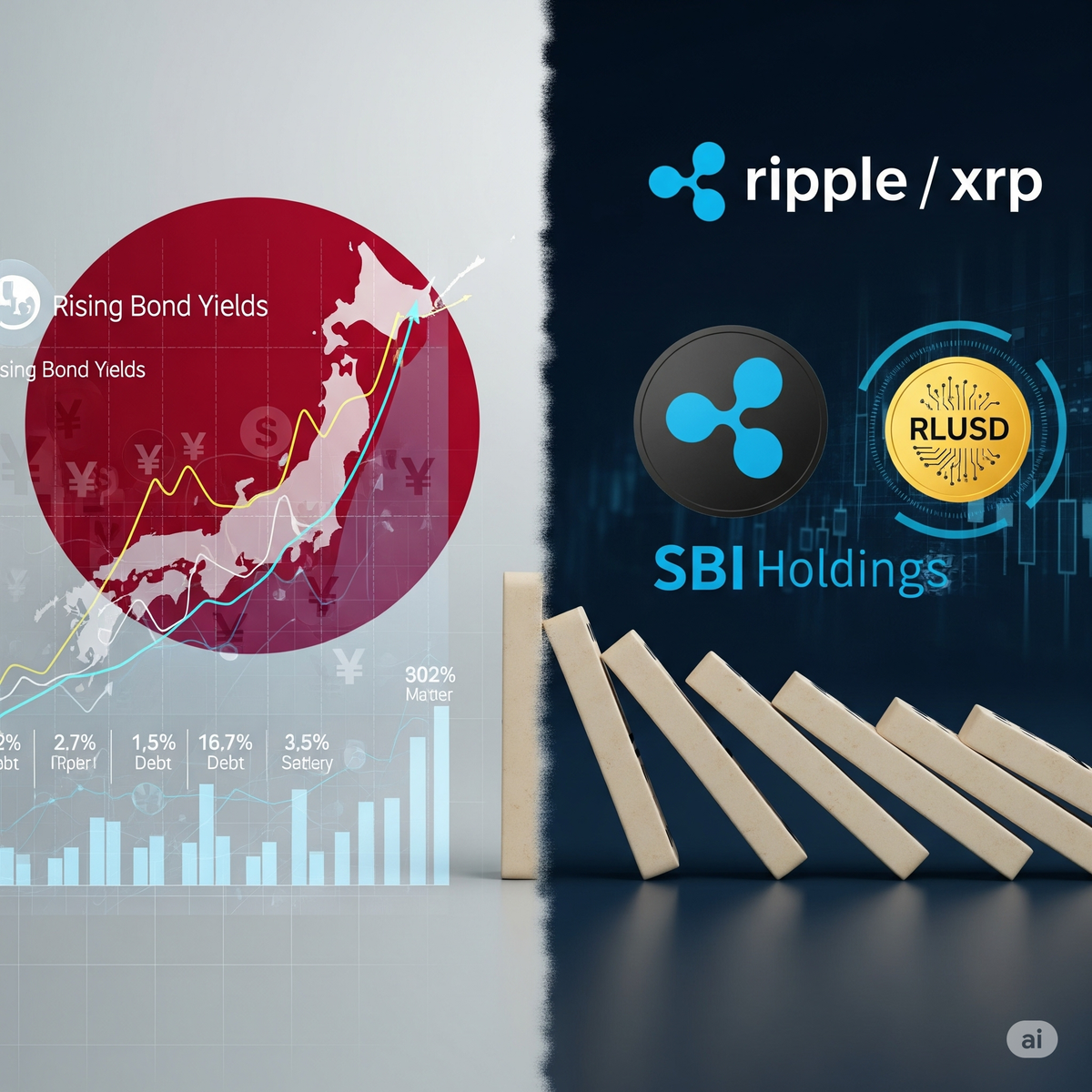Ripple's RLUSD Launch in Japan: Early Warning Signal for Global Debt Crisis?
Ripple's RLUSD launch in Japan comes as the country faces its worst bond crisis since 1987. Is this strategic timing a precursor to global debt contagion? Exploring Claver's domino theory and the unraveling yen carry trade.

Strategic Timing Amid Japan's Financial Crossroads Raises Critical Questions
Ripple and SBI Holdings announced today their partnership to launch RLUSD stablecoin in Japan by Q1 2026, marking a pivotal moment as the country grapples with unprecedented bond market volatility and mounting debt pressures. This strategic move comes as Japan faces what many analysts describe as a potential debt liquidity crisis that could trigger global financial contagion.
Japan's Deteriorating Fiscal Position Creates Perfect Storm
Japan currently carries the world's highest debt-to-GDP ratio at 234.9%, with government debt reaching 1,324 trillion yen by March 2025. More concerning is the recent collapse in demand for Japanese government bonds (JGBs), with Japan's 20-year government bond auction experiencing its weakest demand since 1987, while 40-year yields hit all-time highs.
The Bank of Japan's recent policy shift away from ultra-low rates has exposed the fragility of Japan's debt structure. As the BoJ scales back bond-buying programs with inflation exceeding its 2% target for three consecutive years, reaching 3.6% year-on-year in March 2025, the traditional support system for government debt is crumbling.
Understanding Claver's Domino Theory in Context
Financial analyst Jake Claver's domino theory provides a framework for understanding the potential cascade effects emanating from Japan. Claver's analysis suggests that Japan's financial evolution, including its leadership in central bank digital currency development, could trigger a withdrawal of Japanese institutional investment from US Treasuries, creating a chain reaction across global markets.
The theory outlines five critical phases:
- Japan's Digital Currency Shift: As Japan advances CBDC development, domestic capital retention becomes more attractive
- US Treasury Market Shock: Japanese divestment could trigger broader selling pressure
- Stablecoin Volatility: Traditional stablecoins backed by government securities face instability
- Institutional Crypto Losses: Traditional institutions suffer unexpected digital asset losses
- Stock Market Selloffs: Forced liquidations amplify market downturns
The Reverse Carry Trade Catalyst
Japan's decades-long role as the world's funding currency is rapidly unwinding. The yen carry trade, where investors borrowed cheap yen to invest in higher-yielding assets globally, generated trillions in global capital flows. As Japanese rates rise and the yen strengthens, this massive trade is reversing, forcing capital repatriation.
Japanese life insurance companies and pension funds, managing over $2.6 trillion in assets, are becoming net sellers of ultra-long JGBs and retreating from foreign debt markets. This shift represents a fundamental change in global capital flows that has supported US markets for decades.
RLUSD: Precursor or Solution?
The timing of Ripple's RLUSD launch through SBI appears strategically significant. RLUSD, fully backed by U.S. dollar deposits, short-term Treasuries and cash equivalents with monthly third-party attestations, offers institutional-grade compliance that could provide stability during market turbulence.
With RLUSD holding a $666 million market capitalization as the eighth-largest stablecoin, its introduction to Japan's regulated market could serve as a bridge during the transition away from traditional funding mechanisms.
The Geopolitical Architecture Play
Crypto analyst Pumpius offers a provocative interpretation of this development, describing RLUSD as "the digitized USD warhead embedded into Asia." This perspective suggests the partnership represents more than financial innovation—it's geopolitical architecture designed to weaponize the USD through blockchain rails.
Pumpius argues that Japan serves as the "perfect testbed" due to its advanced tech adoption, compliant digital asset rules, and political alignment with the US. He characterizes this as the "sandbox for the blockchain Bretton Woods," positioning Japan as ground zero for a new monetary system built on XRP Ledger infrastructure.
The pipeline Pumpius describes reveals deeper implications:
- US Treasuries + cash → RLUSD: Traditional backing maintains dollar hegemony
- RLUSD → XRP Ledger settlement layer: Creates blockchain-native dollar infrastructure
- SBI ETFs (BTC + XRP pending approval): Opens institutional liquidity floodgates
- Asset tokenization beyond finance: Including genomic data through protocols like DNA Protocol
According to this analysis, SBI isn't merely a partner but Ripple's "Eastern empire" and "proxy empire" that has been building Asia-Pacific infrastructure for two decades. The RLUSD launch represents the culmination of this strategic positioning, creating what Pumpius calls "SWIFT's death certificate."
1/
— Pumpius (@pumpius) August 22, 2025
Ripple & SBI Holdings will launch Ripple USD ($RLUSD) in Japan via SBI VC Trade in Q1 2026.
Officially: RLUSD is “backed by dollar deposits, US Treasuries, and cash equivalents” with monthly attestations.
Unofficially: it’s the digitized USD warhead embedded into Asia.
XRP/Ripple Strategic Implications
This development positions Ripple and XRP at the center of a potential financial transformation:
Price Potential: If Claver's domino theory proves accurate and traditional payment systems face stress, XRP's utility as a bridge currency could drive significant demand and price appreciation.
Business Operations: SBI's distribution of RLUSD enhances Ripple's Asian footprint just as regional financial systems may need alternative liquidity solutions.
Legal Standing: The regulatory clarity provided by Japan's embrace of RLUSD strengthens Ripple's global compliance narrative, particularly relevant given ongoing US regulatory discussions.
Partnership Opportunities: Success in Japan during financial turbulence could accelerate adoption across Asia-Pacific, where many countries are reassessing dollar-dependency.
Adoption Prospects: As Claver notes, institutions like Japan's SBI Holdings are already preparing to use XRP for settlements, while traditional processors like DTCC test blockchain integration, positioning XRP as critical infrastructure during financial crises.
Global Contagion Risks
The interconnected nature of global debt markets means Japan's bond crisis could trigger worldwide effects. With $9.2 trillion in US debt maturing in 2025, supply is overwhelming demand at precisely the moment when Japan - the largest foreign holder of US Treasuries - may begin selling.
This creates a potential cascade: Japanese rate spikes → carry trade implosion → massive US treasury selloff → US bond yields surge → mortgage rates explode → housing market freezes → consumer spending crashes → credit defaults cascade.
Regulatory and Market Implications
Japan's embrace of regulated stablecoins through RLUSD could establish a new standard for digital asset integration during financial stress. The collaboration aims to set a new standard for compliance and utility in Asia's rapidly growing stablecoin market, potentially making Japan a key hub for next-generation financial infrastructure.
The regulatory framework supporting RLUSD's launch may prove crucial if traditional monetary mechanisms become strained. Central bank digital currencies and regulated stablecoins could provide liquidity alternatives when conventional funding markets seize up.
Conclusion: Strategic Positioning Amid Uncertainty
Ripple's RLUSD launch in Japan appears to be more than routine market expansion - it's strategic positioning ahead of potential financial turbulence. Whether serving as an early warning signal or a solution to emerging problems, this development deserves close attention from investors, policymakers, and market participants.
The convergence of Japan's debt crisis, carry trade unwinding, and digital currency adoption creates an unprecedented environment where alternative financial infrastructure may become essential. Ripple and XRP's positioning at this intersection could prove either prescient or fortuitous, depending on how global events unfold over the coming quarters.
Key Takeaway: RLUSD's Japan launch occurs at a critical juncture where traditional financial mechanisms face unprecedented stress, potentially positioning Ripple's technology as essential infrastructure for navigating the next phase of global monetary evolution.
DISCLAIMER: This newsletter is for informational purposes only and does not constitute investment advice or a recommendation to buy, sell, or hold any securities. Investments in cryptocurrencies or other financial assets carry significant risks, including the potential for total loss, extreme volatility, and regulatory uncertainty. Past performance is not indicative of future results. Always consult a qualified financial professional and conduct thorough research before making any investment decisions.
Sources
- TheCryptoBasic - "Ripple and SBI Confirm Launch of RLUSD in Japan" (August 22, 2025)
- Invezz - "Ripple's $666M RLUSD stablecoin to launch in Japan in 2026 with SBI Holdings" (August 22, 2025)
- CoinDesk - "Ripple News: RLUSD Stablecoin to be Distributed in Japan by 2026" (August 22, 2025)
- IG International - "Japan's Bond Market Crisis: Global Implications Of The Yield Surge" (May 21, 2025)
- Wikipedia - "National debt of Japan" (Updated June 22, 2025)
- IndraStra Global - "From Safe Haven to Fault Line: How Japan's Bond Crisis Threatens Global Markets" (2025)
- CNBC - "Japan's bond market ignites fears of outflows from U.S., carry trade unwind and market turmoil" (June 18, 2025)
- Medium/Limitless Investor - "The Japanese Crisis No One Sees Coming: A Massive Threat to The World Economy" by Henrique Centieiro & Bee Lee (June 3, 2025)
- Times Tabloid - "XRP Domino Theory. What Does It Mean? Details" (March 17, 2025)
- The B:Side Way with Chris Myers - "Japan's Bond Market Collapse" (May 20, 2025)



